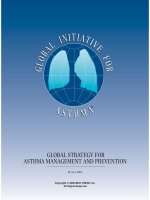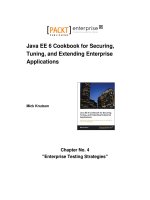Intelligent Centerless Grinding: Global Solution for Process Instabilities and Optimal Cycle Design doc
Bạn đang xem bản rút gọn của tài liệu. Xem và tải ngay bản đầy đủ của tài liệu tại đây (1006.96 KB, 6 trang )
Annals of the CIRP Vol. 56/1/2007 -347- doi:10.1016/j.cirp.2007.05.080
Intelligent Centerless Grinding: Global Solution for Process Instabilities and Optimal
Cycle Design
I. Gallego (3)
Manufacturing Department, Faculty of Engineering – Mondragon University, Mondragon, Spain
Submitted by R. Bueno (1), San Sebastian, Spain
Abstract
Centerless grinding productivity is largely limited by three types of instabilities: chatter, geometric lobing and
workpiece rotation problems. Regardless of its negative effect in manufacturing plants, no functional tool has
been developed to set up the process, because it involves the simultaneous resolution of several coupled
problems. In this paper, new simulation techniques are described to determine instability-free configurations,
making it possible to guarantee that the final workpiece profile is round. With this information and taking into
account other process restrictions, like system static stiffness and workpiece tolerance, the optimal grinding
cycle is designed. These results have been implemented into an intelligent tool to assist the application of this
research in industrial environments.
Keywords:
Centerless Grinding, Productivity, Simulation
1 INTRODUCTION
In centerless grinding, the workpiece is not clamped, but
simply supported between the grinding wheel, the blade
and the regulating wheel (figure 1), reducing the machine
idle time and avoiding the necessity of centring holes on
the workpiece. Due to the enormous manipulating time
and manufacturing cost saving that this implies,
centerless grinding is extensively used in the mass
production of components in automotive and bearing
industries for example.
Nevertheless, the process suffers from three kinds of
instabilities that may limit its precision and productivity.
1) Chatter, whose growing is much more pronounced than
in conventional grinding.
2) Geometric lobing, which appears when the workpiece
does not self-centre and begins to oscillate between the
wheels.
3) Work-holding instability, which appears when the
regulating wheel is not able to make the workpiece spin at
its peripheral velocity.
In previous works, techniques to avoid geometric lobing in
infeed [1] and throughfeed [2] have been shown.
Nevertheless, as stated by Hashimoto, all the problems
should be solved at once, because stable conditions for
one instability may not be so proper for another one [3].
Figure 1: Geometric configuration in infeed grinding.
In this work, a new technology has been developed to
give a global solution to all instabilities at the same time
and design the optimal grinding cycle, so as to obtain the
required workpiece tolerance in the minimum time without
thermal damage. The application of these results in
grinding industry has potentially a great impact, reducing
process set-up time and decreasing production stops
motivated by out-of-roundness issues.
2 PROCESS SIMULATION
2.1 Process equations
In this section, the basic equations governing the
centerless grinding process are shown. A new and more
coherent notation has been employed to simplify some of
the expressions.
Let r
w
(t) and
G
r
w
(t) be the radius and radius defect of the
workpiece in an infeed process (figure 1). The radius
defect varies due to strictly geometric reasons, because
the cutting forces cause changes in the deflection of the
machine, workpiece and wheels, and because vibrations
may arise. This way,
G
r
w
(t) can be expressed as:
ttttr
DKgw
HHHG
(1)
where
H
g
(t) is the geometric displacement of the
workpiece due to roundness errors passing through the
contact points with the blade and regulating wheel.
H
K
(t)
represents the time variation of the system static
deflection (along the cutting direction) and
H
D
(t) is the term
representing the vibrations generated in the process.
The geometric term
H
g
(t) was derived by Dall [4] and
refined by Rowe
et al. [5]. It can be expressed as:
rwrbwbg
WGWGH
trgtrgt (2)
being
bw
WG
tr and
rw
WG
tr the radius defect at the
contact points with the blade and regulating wheel.
g
b
and
g
r
are two geometrical parameters [1].
Geometric lobing stability has been studied in the
frequency domain [6,7]. Applying the Laplace transform to
equation (2), it is obtained:
T
J
r
h
M
M
J
J
r
J
s
Grinding wheel Regulating wheelBlade
Workpiece
-348-
r
b
rbwg
W
W
H
s
s
egegsRs
(3)
In a grinding process, the cutting force
F
c
(t) and the
instant depth of cut,
a
e
(t) are related by a parameter
called cutting stiffness (k
w
):
)(
ewc
taktF (4)
The cutting force produces a deflection of the machine,
wheels and workpiece, which makes the radius reduction
to accumulate a delay in relation to the programmed feed.
From a stability point of view, it is not a matter of interest
to know the delay, but the variations in deflection
generated by the radius defect evolution. Defining
W
as
the rotation period of the workpiece, it is obtained:
trtrktF
wwwc
GWGG
(5)
The second term of equation (1) can be expressed as:
eq
c
K
k
tF
t
G
H
(6)
where
k
eq
is the equivalent stiffness of the system.
k
eq
can be determined in two different ways:
experimentally or theoretically with the help of a data-
base. In the first case, several tests must be performed
employing different feed levels. Based on the difference
of diameters between tests with and without spark-out,
the relation of the cutting force and the total deflection of
the system can be obtained. In the second case, the
value of k
eq
can be predicted analytically using this
expression:
1
crr
1
cs
1
m
1
eq
kgkkk (7)
This equation is derived from a spring-model, which
includes the machine and blade stiffness (k
m
) and the
wheels/work contact stiffness (k
cs
, k
cr
). Determination of
equivalent stiffness and its dependencies on feed rate,
wheel type, etc. is essential to predict instabilities
accurately [8,9].
Regarding cutting stiffness, its value may be estimated
with analytical approximations, but a final experimental
calibration is recommended to have chatter prediction
maps and the optimal grinding cycle very close to reality.
Introducing expression (5) in equation (6):
trtrKtrtr
k
k
t
wwww
eq
w
K
GWGGWGH
(8)
K parameter represents the flexibility of the system and
relates the amount of deformation of the system to
different depths of cut.
Centerless grinding chatter was extensively studied by
Miyashita, Hashimoto
et al. [10,11] and Rowe et al.
[12,13,14]. These authors developed successful models
that can be used to predict chatter-free configurations.
Bueno et al. [8] and Nieto et al. [15] determined the
threshold stability value of the cutting stiffness as a
function of the workpiece rotation frequency and
introduced non linear effects in the model, such as the
spark-out and lobe filtering. Hashimoto and Zhou [16]
proved that filtering effects have a big effect on high
waviness stabilisation. According to these authors,
contact stiffness is again an important factor on chatter
growing, as it has been stated for other types of grinding
processes too [17].
To introduce vibrations in the model, the dynamic
flexibility of the machine
H(s) may be used. Centerless
grinding process is usually well defined with a two-
dimensional modal analysis at the three points of contact
between the workpiece, blade and wheels. Nevertheless,
if
H(s) is introduced in the model without any correction, it
will add an extra contribution to the static deflection of the
system, already considered in equation (8). Subtracting
this contribution, the expression of
H
D
in Laplace domain
turns into:
Ư
á
á
ạ
ã
ă
ă
â
Đ
m
1
2
r
r
rr
22
r
r
wwD
2
1
N
r
s
V
ss
V
esRks
ZZ[Z
H
W
(9)
N
m
: number of considered vibration modes.
m
r
,
Z
r
,
[
r
: modal mass, frequency and damping of r mode.
V
r
may be expressed in this way:
^`
^`^`
^`
PXXCV
T
rr
T
r
(10)
{X
r
}: vector containing the relative deformations at the
contact points of r mode.
{C}: vector quantifying the real displacement at the cutting
point due to a displacement of the contact points.
{P}: vector relating the forces at the contact points with
the normal force at the cutting point.
The last term in equation (9) is the referred correction to
H(s). We consider that this is an essential enhancement
of preceding models, as it has a significant influence on
the dynamic stability maps shown in section 4. In addition,
it should be pointed out that when vibrations are
introduced in the model, it is very important not to
disregard the static term
H
K
(t), because it may be proved
that, in that hypothetical case, geometric lobing could
appear with lobe numbers very far from integer, which is
not physically possible.
Rearranging all the terms deduced in equation (1):
0
1
2
11
m
r
b
1
2
r
r
rr
22
r
r
w
rb
w
ắ
ẵ
đ
ằ
ằ
ẳ
ô
ô
ơ
ê
Ư
W
W
W
W
ZZ[Z
s
N
r
s
s
s
e
V
ss
V
k
eKegeg
sR
(11)
As it is well known, the poles of
'
R
w
(s) will define whether
the process is stable or not. The poles can be expressed
in terms of defect regeneration frequency (
Z
) and
damping (
[
): s=-
Z[
+i
Z
(1-
[
2
)
1/2
. Regeneration will be
unstable for
[
<0. For that reason, it is necessary to find
the roots of the next function:
W
W
W
ZZ[Z
s
N
r
s
s
e
V
ss
V
kK
egegs
á
á
ạ
ã
ă
ă
â
Đ
ằ
ằ
ẳ
ô
ô
ơ
ê
Ư
1
2
1f
m
r
b
1
2
r
r
rr
22
r
r
w
rb
(12)
In the next section, the methodology to get all the
significant roots of f(s) is shown.
All these equations have been deduced for plunge
processes. The adaptation of the model for throughfeed
processes was explained by Meis [18] and Gallego et al.
[2].
Other remarkable approaches to improve productivity can
be found in the bibliography, like the one recently
proposed by Klocke et al. [19], which involves working
below center so that higher feed rates can be employed,
-349-
but using a new type of functional blade to avoid
geometric lobing. Other authors, like Harrison and Pearce
[20], have proposed changing machine configuration in-
process to allow a faster correction of the initial
roundness error of the workpiece.
Finally, it should be mentioned that the equations to
establish the limits for work rotation instabilities were
deduced by Hashimoto et al. [21].
2.2 Instabilities determination
In contrast to milling process, where it is just necessary to
know the chatter limits, in centerless grinding it is also
necessary to determine the absolute value of the stability
degree of the process. This is because at the optimal
configuration, where all the lobes are stable with the
maximum possible stability degree, initial roundness error
correction is faster. This way, the process is less sensitive
to changes in the roundness of entering workpieces and a
final round profile may be obtained.
Consequently, the development of a completely reliable
and efficient method is the key to determine the best
working configuration in a reasonable time. This is one of
the major contributions of this work. In the past, several
types of techniques have been employed: graphical
methods [11], numerical methods [22], Taylor’s series
approximation [9] or the Simplex method [23].
Established that f(s) is a complex function of complex
variable, those s values which verify f(s)=0 will also verify
|f(s)|
2
=0. Naming
D
and
E
the real and imaginary parts of
s, the function is graphically shown in figure 2. This way,
pole-finding of
'
R
w
(s) has been transformed into root
finding of a real function of two real variables. Being |f(s)|
2
positive, the problem is transformed into finding local
minima. |f(s)|
2
has many minima close to
D
=0 axis. Those
configurations with positive real part roots (i.e.
[
<0), will
be unstable. Those configurations with negative real part
in all the roots, with the highest possible absolute value,
will be the optimal configurations.
The solution to this problem is to use an appropriate
mesh in the (
D
,
E
) plane and then, starting from each point
of the mesh, apply the best possible optimisation
algorithm to find the closest minimum as fast as possible.
With regard to the mesh, it is easy to demonstrate that
the characteristic function can not have two different
minima for the same value of
E
near
D
=0. This way, the
mesh in
D
can be avoided. The optimum mesh is a row of
points at
D
=0 from
E
=
Z
w
to
E
=n
max
Z
w
, where
Z
w
is the
rotation speed of the workpiece and n
max
is the maximum
number of lobes that can appear over the workpiece,
usually not higher than 40 or 50. The number of points
recommended for the
E
grid is n
max
.
The best optimisation algorithm for the |f(s)|
2
function is
Levenberg-Marquardt [24]. This algorithm is a hybrid
method that combines the safe local convergence given
by the steepest descent algorithm with the Newton
method for a faster convergence. The only problem is that
it is necessary to determine the first and second
derivatives of the function analytically, leading to quite
complex expressions. Nevertheless, by rearranging terms
it is possible to include as many modes as desired in the
function without excessive complication of expressions.
The advantage of this technique is that it is possible to
determine whether a certain working configuration is
stable or not considering all instabilities in less than 0.1
seconds in an average computer. Repeating the calculus
for many configurations it is possible to plot stability maps
like the ones shown in the next sections.
Figure 2: |f(s)|
2
function.
3 GEOMETRIC LOBING SUPPRESSION
The two previous works on geometric lobing in infeed and
throughfeed [1,2] have led to the development of a
commercial set-up software, called Estarta SUA (Set Up
Assistant). As an example, in figure 3 a stability map of
the process is shown as represented in Estarta SUA.
Stability maps are 2D or 3D graphs that define stable and
unstable areas for different set-up parameters. In the
case of geometric lobing, stability maps are plotted as a
function of the blade angle (ș) and workpiece height
above centre (h), two variables that are easily controlled
by machine operators. Figure 3 has been obtained for the
next conditions: wheels and workpiece diameters
D
s
= 630 mm, D
r
= 310 mm and D
w
= 36 mm; K = 2.9;
Q’ = 1.13 mm
2
s
-1
; feed: 1.2 mm min
-1
;
Z
r
= 15 min
-1
.
The reliability of geometric lobing simulation is
guaranteed by the fact that it is daily used by Estarta
manufacturer and its customers with optimal results.
4 CHATTER PREDICTION
Centerless grinding is especially sensitive to chatter. The
high value of cutting stiffness that arise when grinding
long workpieces causes the excitation of the main
vibration modes (opening and closing of wheelheads) and
also modes associated to the workblade. In centerless
grinding, chatter caused by regeneration of a lobed profile
on grinding wheels is less common than in other
processes and will not be considered in this work.
Chatter presents a great dependence on workpiece
rotation frequency. Because of this, it is interesting to
obtain stability maps for any combination of blade angle
(ș), workpiece height (h) and regulating wheel rotating
frequency (
Z
r
), including at the same time geometric and
dynamic phenomena.
Figure 3: Geometric lobing stability map. In blue: stable
areas. In red: unstable configurations.
0 5 10 15 20 25
50
40
30
20
10
Height (mm)
Blade Angle (º)
5
7
36
32
28
24
20
16
31
35
22
18
33
14
22
24
26
28
18
31
33
35
14
16
18
20
22
24
26
28
30
32
34
36
34
36
32
30
28
26
30
32
34
36
34
9
36
26
10
15
10
5
0
0
0.5
-0.5
10
15
20
D
E
-350-
0 5 10 15
Height (mm)
Figure 4. Chatter and geometric lobing stability map. In
dark blue: stable areas. In red: unstable areas. Star size
is proportional to the experimental vibration amplitude,
round points represent tests without chatter.
In figure 4 a stability map is shown as a function of h and
Z
r
for a blade angle of 30º. Red areas represent
configurations susceptible to chatter, light blue zones
correspond to geometric lobing, while dark blue areas are
stable for both chatter and geometric lobing. Black lines
separate stable and unstable areas.
Several tests have been performed in order to check the
simulations, using two grinders of different manufacturers
in the next conditions:
1. Machine 1: small grinder, wheelhead power 8 KW,
wheelhead opening frequency: 90.8 Hz;
T
= 30º; D
s
=
= 325 mm, D
r
= 220 mm, D
w
= 24 mm; workpiece
length: L
w
= 25 mm; K
eq
= 14.2 N/Pm; Q’ =
= 0.75 mm
2
s
-1
; feed: 1.2 mm min
-1
.
2. Machine 2: large grinder, wheelhead power 60 kW,
wheelhead opening frequency: 58.3 Hz;
T
= 30º; D
s
=
= 628 mm, D
r
= 340 mm; D
w
= 47 mm; L
w
= 368 mm;
K
eq
= 69.7 N/Pm; Q’ = 1.23 mm
2
s
-1
; feed: 1 mm min
-1
.
In the theoretical maps obtained for these cases, chatter
free and geometric lobing free areas can be observed
when using low heights and workpiece rotation speeds,
as well as some transient areas at higher rotation speeds.
There are also stable areas elsewhere, but they are too
small from a practical point of view to be used.
For machine 1, the map is checked with experimental
results in figure 4. The size of the stars is proportional to
the experimental vibration amplitude, while the round dots
mean that no dynamic instability is excited. A good
correlation is observed between simulation and
experimental results.
For machine 2, the simulation has been likewise reliable,
in spite of the fact that the machine and process are very
different from the previous case.
A remarkable property observed in the theoretical maps is
that the size of unstable areas changes as a function of
the equivalent stiffness. For a given machine, changes in
contact stiffness caused by workpiece length, feed rate or
wheel type have an impact on stability maps and explain
dynamic variations observed in production plants. For
example, a more flexible regulating wheel reduces the
size of unstable areas significantly.
It should be noted the importance of the existence of
dynamically and geometrically stable zones on the maps
at high rotating speeds. It has been proved that in these
configurations, as the workpiece turns many revolutions
during the process, better roundness and roughness
qualities are achieved. Moreover, a high rotating speed
also prevents the workpiece from thermal damage.
On the other hand, as we presented for geometric lobing
|1,2], it is possible to solve the equations in time domain.
This possibility opens new ways for chatter suppression,
such as variable workpiece rotation velocity. This point
will be discussed in a future work.
5 WORK ROTATION INSTABILITY AVOIDANCE
The regulating wheel is the element controlling the
rotational movement of the workpiece, exerting a brake
moment over it by friction. In certain conditions, for
example when high feed velocities or dull wheels are
employed, the workpiece dragging becomes unstable,
generating shakes, irregular velocities, jumps and
accelerations, with risks for machine operators.
In the absence of other kind of instabilities, these
phenomena are the limiting factor to productivity, because
the process feed defines the cutting force exerted by the
grinding wheel and the required brake moment to control
the movement of the workpiece. On the other hand,
another function of the regulating wheel is to rotate the
workpiece before beginning the grinding process. If the
workpiece does not rotate, a flat band may be generated
in the periphery of the workpiece.
As mentioned before, the model and equations describing
these phenomena were fully developed by Hashimoto et
al. [21]. The model is conditioned by how precisely the
values of the friction coefficients in the contacts (
P
b
,
P
r
)
are introduced. With this objective two methodologies
have been developed: one in laboratory and another in
situ in the process. In laboratory, tribometer
measurements have been performed with disc-on-disc
geometry, due to its similarity with the real process, using
pressures at the contact area identical to real processes.
To obtain the values in situ, two force sensors in the
slides and a Kistler plate under the workblade have been
employed.
On tables 1 and 2 the results obtained for a specific wheel
(rubber based A80 regulating wheel in contact with
hardened F-522 steel) are displayed. The friction
coefficient depends strongly on the wheel topography
(related to the dressing and the wheel wear) and the
lubricant used, but not so strongly on the exerted
pressure and the grain mesh. The working configuration
employed in table 2 belongs to a working regime in which
the regulating wheel has no problem to hold back the
workpiece, as the relationship between tangential and
normal forces at the contact point (
n
r
t
r
FF ) is smaller
than the limit friction coefficient.
Based on these friction coefficient values, it is easy to plot
stability maps as a function of feed, h,
T
,
Z
r
or other
parameters, showing spinning free areas (see figure 5).
With the aid of these maps, it is possible to know the
available margin to increase the feed without risks.
6
8
10
12
14
16
18
20
22
21
19
9
11
13
15
17
21
19
9
11
13
15
17
7
Regulating wheel speed (min
-
1
)
-5
-351-
Rough dressing Fine dressing
Pressure (MPa) ȝ
R
Pressure (MPa) ȝ
R
70 0,29 70 0,22
100 0,31 100 0,19
Table 1: Friction coefficients between regulating wheel
and F-522 steel as obtained in tribometer for different
dressing conditions and pressures.
Rough dressing Fine dressing
Feed
mm/min
Pressure
MPa
n
r
t
r
F
F
Feed
mm/min
Pressure
MPa
n
r
t
r
F
F
1,6 45 0,25 1,6 52 0,20
3,2 59 0,25 3,2 73 0,20
5,7 72 0,25 5,7 89 0,20
8 86 0,24 - - -
Table 2: Relationship between tangential and normal
forces at regulating wheel-steel contact as obtained in a
sensorised grinder for different dressing conditions and
pressures.
In a future paper, a complete study of friction coefficient
values for different wheels and conditions will be shown.
6 OPTIMAL CYCLE DESIGN
The main reference on optimal cycle calculation in
grinding processes is the work developed by Malkin [25].
Based on this work, the author has successfully
developed the GrindSim software to set-up and optimise
cylindrical grinding processes.
Two possible criteria can be used to design a centerless
grinding cycle: 1) Minimise the process cycle time or 2)
Adjust the cycle to a previously established process time,
minimising wheel wear. This last option is very common in
production lines.
The process parameters to be optimised include the feed
for each stage of the infeed cycle, the stock removal in
each stage and the spark-out time. The restrictions to
apply are given by the maximum power to employ in the
roughing process free from burning problems [25] and the
required tolerance and roughness of the final workpiece.
To define the optimal cycle, the feeds to use are fixed
first. The first feed will depend on the criteria chosen to
optimise the cycle. In the first case, it is deduced from the
maximum power that is possible to use. If production time
is pre-established the strategy is similar, although it is
Figure 5: Work rotation stability map for 5 mm/min feed
and a dull regulating wheel (friction coefficient: 0.20).
Figure 6. Grinding cycle evolution with 4 feeds and spark-
out: (a) Deflection. (b) Real radius of workpiece (blue) and
programmed position for the wheel (black).
necessary to employ iterative methods. Once the
roughing feed is known, the rest are obtained through a
series of given relations (depending on the wheel in use).
Machining time for each feed can be calculated by
establishing a proportionality with the deflection (
G
)
accumulated in the previous stage (figure 6a), although it
would still be necessary to determine the time for the first
stage and the spark-out. The referred proportionality can
be adjusted depending on how aggressively we want to
design the process.
The spark-out time is calculated establishing that the
exponential reduction of the radius defect fits the required
radial tolerance (
G
f
<
G
tol
), ensuring also that, during a time
interval before and after the process stops, the workpiece
is within tolerances. It should be noted that the
programmed final position of the wheel exceeds slightly
the desired dimension of the workpiece (figure 6b), in the
same quantity as the average accumulated radius defect
at the end of the process.
CONCLUSIONS
The main conclusions of this work can be summarised as
follows:
1. Both an enhanced model and computation algorithm
for centerless grinding have been developed.
2. All the process instabilities can be predicted together.
At the optimal configuration, roundness correction is
faster, making the process less sensitive to changes
in the quality of entering workpieces.
3. Grinding cycles have been designed to obtain the
required workpiece tolerance at minimum production
time or, alternatively, minimum wheel wear.
Practical application of these results may increase
significantly precision and productivity of many industrial
processes, reducing set-up time and decreasing
production stops motivated by chatter or out-of-roundness
issues.
0
2 4
6
8
0
2 4
6
8
(a)
(b)
1
3
2
4
0
x 10
-2
12.0
11.9
11.8
11.7
Time (s)
Radius (mm)
System deflection (mm)
G
1
G
2
G
3
G
4
G
f
Tolerance,
G
tol
Tolerance
Spinning Free Zone
Transition Zone
Spinning Zone
Blade angle (º)
-5 0 5 10 15
10
15
20
25
30
35
40
45
50
Height (mm)
-352-
To assist the implementation of grinding simulation in
industry, an intelligent software tool has been developed
(Estarta SUA), which can be incorporated into the CNC
control of centerless grinders.
7 ACKNOWLEDGMENTS
This work has been carried out with the financial support
of the Basque Country Government (projects UE 2005-4
and IT-2005/043) and the Spanish Government (projects
FIT-020200-2003-72 and DPI2003-09676-C02-01).
The author wishes to acknowledge his colleagues from
Ideko Tecnological Centre (R. Lizarralde, D. Barrenetxea
and G. Aguirre), Mondragon University (J. I. Marquínez, J.
Madariaga and R. Fernández), Estarta (I. Muguerza) and
Manhattan Abrasives (P. Cárdenas) for their contribution
to this work.
8 REFERENCES
[1] Lizarralde, R., Barrenetxea, D., Gallego, I.,
Marquinez, J.I., 2005, Practical Application of New
Simulation Methods for the Elimination of Geometric
Instabilities in Centerless Grinding, Annals of the
CIRP, 54/1:273-276.
[2] Gallego, I., Lizarralde, R., Barrenetxea, D., Arrazola,
P.J.; 2006, Precision, Stability and Productivity
Increase in Throughfeed Centerless Grinding,
Annals of the CIRP, 55/1: 351-354.
[3] Hashimoto, F., Lahoti, G.D., 2004, Optimization of
Set-up Conditions for Stability of The Centerless
Grinding
Process, Annals of the CIRP, 53/1:271-
274.
[4] Dall, A.H., 1946, Rounding Effect in Centreless
Grinding, Mechanical Engineering, 58:325-329
[5] Rowe, W.B., Koeningsberger, F., 1965, The Work
Regenerative Effect in Centerless Grinding, Int. J.
Mach. Tool Des. Res., 4:175-187.
[6] Reeka, D., 1967, On the Relationship Between the
Geometry of the Grinding Gap and the Roundness
Error in Centerless Grinding, PhD Diss., Tech.
Hochschule, Aachen.
[7] Furukawa Y., Miyashita M., Shiozaki S., 1971,
Vibration Analysis and Work-Rounding Mechanism
in Centerless Grinding, Int. J. Mach. Tool Des. Res.,
vol. 11, pp. 145-175.
[8] Bueno, R., Zatarain, M., Aguinagalde, J.M., 1990,
Geometric and Dynamic Stability in Centerless
Grinding, Annals of the CIRP, 39/1:395-398.
[9] Zhou, S.S., Gartner, J.R., Howes, T.D., 1996, On
the Relationship between Setup Parameters &
Lobing behavior in Centerless Grinding, Annals of
the CIRP, 45/1:341-346.
[10] Miyashita, M., 1972, Unstable Vibration Analysis of
Centerless Grinding System and Remedies for its
Stabilisation, Annals of the CIRP, 21/1:103-104.
[11] Miyashita M., Hashimoto F., Kanai A., 1982,
Diagram for Selecting Chatter Free Conditions of
Centerless Grinding, Annals of the CIRP, 33/1:221-
223.
[12] Rowe, W.B., Bell, W.F., Brough, D., 1986,
Optimization studies in high removal rate centreless
grinding, Annals of the CIRP, 35/1: 235-238.
[13] Rowe, W.B., Bell, W.F., Brough, D., 1987, Limit
Charts for High Removal Rate Centerless Grinding,
Int. J. Mach. Tools Des. Res., 27/1:15-25.
[14] Rowe, W.B., Miyashita, M., Koenig, W., 1989,
Centerless Grinding Research and Its Application,
Annals of the CIRP, 38/2:617-624.
[15] Nieto, F.J., 1996, Estudio teórico y experimental del
comportamiento dinámico en las rectificadoras sin
centros en sus dos formas de operación:
penetración y pasante, PhD Diss., Universidad de
Navarra, San Sebastián.
[16] Hashimoto, F., Zhou, S.S, Lahoti, G.D., Miyashita,
M., 2000, Stability Diagram for Chatter Free
Centerless Grinding and its Application in Machine
Development, Annals of the CIRP, 49/1:225-230.
[17] Inasaki, I., Karpuschewski, B., Lee, H S., 2001,
Grinding Chatter - Origin and Suppression, Annals
of the CIRP, 50/2:515-534.
[18] Meis, F.U., 1980, Geometrische und kinematische
Grundlagen für das spitzenlose Durchlaufschleifen,
PhD Diss., Aachen
[19] Klocke, F., Friedrich, D., Linke, B., Nachmani, Z.,
2004, Basics for In-Process Roundness Error
Improvement by a Functional Workrest Blade,
Annals of the CIRP,
53/1:275-280.
[20] Harrison, A.J.L., Pearce, T.R.A., 2004, Reduction of
Lobing in Centreless Grinding via Variation of Set-up
Angles, Key Engineering Materials, 257-258:159-
164.
[21] Hashimoto, F., Lahoti, G.D., Miyashita, M., 1998,
Safe Operations and Friction Characteristics of
Regulating Wheel in Centerless Grinding, Annals of
the CIRP, 47/1:281-286.
[22] Frost, M.; Fursdon, P.M.T., 1985, Towards optimum
centerless grinding. ASME M.C. Shaw Grinding
Symposium:313-328.
[23] Harrison A. J. L., Pearce T. R. A., 2002, Prediction
of lobe growth and decay in centreless grinding
based on geometric considerations Proc. Instn.
Mech. Engrs., Part B: J. Engineering Manufacture,
216:1201-1216.
[24] Gallego, I., Barrenetxea, D., Rodríguez, A.,
Marquínez, J. I., Unanue, A, Zarate, E., 2003,
Geometric lobing suppression in centerless grinding
by new simulation techniques, The 36th CIRP-
International Seminar on Manufacturing
Systems:163-170.
[25] Malkin, S., 1989, Grinding Technology: theory and
applications of machining with abrasives, Society of
Manufacturing Engineers, Dearborn, Michigan









